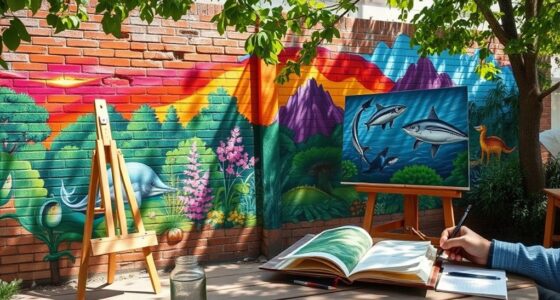Artists are increasingly turning to their creativity to raise awareness about environmental issues. Through striking visuals, public murals, and immersive installations, they connect people emotionally to conservation efforts. These artistic approaches not only highlight urgent challenges but also inspire action in communities. As you explore how art can serve as a powerful tool for activism, you’ll discover how these creative efforts are shaping the future of environmental advocacy—and why their impact is worth understanding.
The Power of Visual Storytelling in Conservation
Visual storytelling has become a vital tool in conservation efforts because it can evoke strong emotional responses and create a sense of urgency. When you see powerful images of endangered species or devastated habitats, you feel compelled to act. Creating Your Perfect Backyard Greenhouse can also serve as a visual metaphor for nurturing growth and protecting the environment. Visual stories cut through complex data and scientific jargon, making environmental issues accessible and relatable. They tap into your emotions, sparking empathy and motivating change. Using striking photos, compelling videos, and vivid narratives, artists and activists bring environmental challenges to life in a way that words alone often can’t. This emotional connection encourages viewers to support conservation initiatives or change their behaviors.
Murals and Street Art as Platforms for Environmental Awareness
Murals and street art have become powerful platforms for raising environmental awareness by transforming public spaces into open-air galleries that demand attention.
When you walk through city streets, you notice vibrant images highlighting endangered species, pollution, or climate change. These artworks make complex issues accessible and emotionally impactful, inspiring viewers to reflect and act.
Artists strategically choose visible locations to reach broad audiences, turning blank walls and alleyways into powerful messages. Their art sparks conversations among pedestrians, residents, and tourists alike, making environmental issues impossible to ignore.
Unlike traditional campaigns, street art offers immediacy and authenticity, creating a communal sense of urgency. By leveraging public spaces, artists turn everyday environments into visual calls for action, making conservation messages unavoidable and memorable.
Interactive and Immersive Installations That Engage Communities
Interactive and immersive installations have emerged as dynamic tools for engaging communities in environmental activism. You can step into these environments and experience the issues firsthand, making the message personal and impactful.
Artists design these installations to evoke emotion, provoke thought, and inspire action. For example, you might walk through a recreated ecosystem that highlights pollution’s effects or interact with sculptures that respond to your movements, illustrating human impact.
These installations foster a sense of participation, breaking down barriers between audiences and the message. By involving viewers directly, they transform passive observation into active engagement.
As a result, communities feel connected and motivated to support conservation efforts, turning awareness into tangible action. Incorporating self watering plant pots in these displays can demonstrate sustainable practices and innovative solutions for water conservation, further enhancing the educational impact of the installations. This approach makes environmental activism more accessible and memorable for everyone involved.
Using Art to Highlight Endangered Species and Habitats
How can art shed light on endangered species and fragile habitats? You can create striking visuals that capture the unique beauty of these creatures and environments, making them impossible to ignore. Incorporating color accuracy into artwork ensures that the visual message is conveyed with true-to-life hues, enhancing emotional impact. Artists often use vivid paintings, sculptures, or murals to depict species on the brink of extinction, evoking emotional responses that motivate action. By highlighting the delicate balance of ecosystems, art raises awareness about threats like deforestation, pollution, and climate change. Public art installations placed in natural or urban settings can spark conversations and inspire conservation efforts. When you use art to focus on endangered species and habitats, you turn abstract issues into tangible experiences, encouraging viewers to see the importance of protecting our planet’s most vulnerable life forms.
Collaborations Between Artists and Environmental Organizations
Collaborations between artists and environmental organizations create powerful opportunities to amplify conservation messages and mobilize communities. When you team up with these groups, your art can reach wider audiences and inspire action. You might create murals, installations, or performances that highlight urgent ecological issues, making them more tangible and emotionally resonant. These partnerships often provide resources, platforms, and credibility that amplify your voice. By working together, you can develop projects that engage the public in meaningful ways, encouraging local participation and raising awareness. Such collaborations also lend legitimacy to your activism, helping to influence policymakers and funders. Integrating dog breeds into your artwork can also serve as a symbol of loyalty and companionship in conservation efforts. Ultimately, your combined efforts can spark conversations, shift perceptions, and foster a collective commitment to protecting the environment.
Digital Art and Virtual Reality in Conservation Campaigns
Artists are increasingly harnessing digital technology and virtual reality to enhance conservation campaigns, creating immersive experiences that resonate deeply with audiences. Virtual reality transports you into endangered habitats, allowing you to witness the beauty and fragility of ecosystems firsthand.
Digital art platforms enable artists to craft compelling visuals and interactive stories that highlight environmental issues. These tools make abstract problems tangible, encouraging empathy and action.
For example, VR experiences might take you beneath the ocean surface or into deforested areas, fostering a personal connection. By blending art and technology, artists motivate change more effectively, breaking down complex conservation messages into engaging, memorable encounters.
Implementing educational content within these experiences further deepens understanding and inspires long-term commitment to environmental preservation.
This approach not only raises awareness but also empowers you to become an active participant in protecting the planet.
Art Festivals and Exhibitions Focused on Ecological Issues
Ecological issues have become a central theme in many contemporary art festivals and exhibitions, drawing attention to urgent environmental challenges through powerful visual storytelling. These events create platforms where artists showcase works that highlight climate change, pollution, deforestation, and species loss, inspiring viewers to reflect and act. You’ll find installations, sculptures, and multimedia pieces that provoke deep emotional responses and foster awareness. Many festivals also include interactive components, such as participatory art or live performances, encouraging community engagement. Incorporating eco-friendly materials and sustainable practices in art creation is also gaining prominence, demonstrating a commitment to environmentally conscious art.
The Role of Art in Inspiring Behavioral Change
Art has a powerful ability to inspire behavioral change by resonating emotionally and sparking reflection. When you engage with meaningful artwork, you’re more likely to feel connected to environmental issues and reconsider your habits. Incorporating essential oils into daily routines can also support well-being and reinforce positive behaviors. Artistic expressions can challenge your perceptions, making abstract concepts like climate change feel personal and urgent. For example, vivid visuals or compelling installations can evoke empathy, motivating you to reduce waste or support conservation efforts. Art also creates shared experiences, encouraging communities to unite around common goals. By stirring emotions and fostering understanding, art moves you from awareness to action. Ultimately, it’s not just about appreciating beauty but about inspiring you to adopt sustainable behaviors that benefit the planet.
Case Studies: Successful Artistic Campaigns for the Environment
One of the most impactful examples of artistic campaigns driving environmental change is the “Ice Memory” project, which uses stunning visual installations to highlight the loss of polar ice due to climate change. By capturing melting ice cores and transforming them into compelling art pieces, this campaign raises awareness about global warming’s urgent effects. Additionally, leveraging European cloud infrastructure can help artists share their work globally with sustainable and secure digital platforms. Another powerful example is the “Plastic Ocean” exhibit, where artists create sculptures from discarded plastics, turning trash into thought-provoking installations that challenge viewers to reconsider their consumption habits. The “Tree Orchestra” project uses interactive art to reconnect communities with deforestation issues, encouraging activism through immersive experiences. These campaigns succeed because they combine visual impact with clear messages, inspiring action and fostering a deeper emotional connection to environmental causes.
How Art Education Promotes Environmental Stewardship
When students engage in art education focused on environmental themes, they develop a deeper understanding of ecological issues and their personal responsibility to protect the planet. Through hands-on projects like creating eco-friendly sculptures or illustrating climate change, you connect emotionally with environmental challenges. Incorporating the concept of environmental stewardship into art projects helps reinforce the importance of caring for natural resources. This active involvement fosters empathy and inspires action. Art education encourages you to see the interconnectedness of nature and society, prompting you to think critically about sustainable practices.
As you explore topics such as pollution or conservation, you gain awareness of your impact and how to advocate for change. By integrating art with environmental learning, you’re more likely to embrace stewardship, develop creative solutions, and carry these values into everyday life.
This approach empowers you to be a proactive participant in safeguarding the environment.
Conclusion
You see how art can powerfully inspire change by making environmental issues real and urgent. Through murals, installations, and collaborations, you can help spread awareness and motivate others to act. By engaging communities and transforming public spaces, your creative efforts can drive meaningful conservation. Remember, your art has the potential to spark conversations, foster stewardship, and turn awareness into action. Keep using your talent to make a positive impact on our planet.






